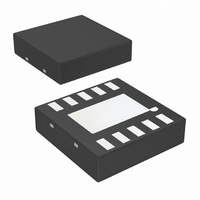LMV242LD/NOPB National Semiconductor, LMV242LD/NOPB Datasheet - Page 12

LMV242LD/NOPB
Manufacturer Part Number
LMV242LD/NOPB
Description
IC GSM POWER AMP CTRLR 10LLP
Manufacturer
National Semiconductor
Datasheet
1.LMV242LDNOPB.pdf
(16 pages)
Specifications of LMV242LD/NOPB
Rf Type
Cellular, GSM, GPRS, TDMA, TD-SCDMA, WLL
Frequency
450MHz ~ 2GHz
Features
Power Amplifier Controller
Package / Case
10-LLP
Lead Free Status / RoHS Status
Lead free / RoHS Compliant
Other names
LMV242LD
LMV242LDTR
LMV242LDTR
www.national.com
Application Section
We will assume initially that the output of the PA is at some
low level and that the V
converter converts the V
I
pacitor C. Current flow from this direction increases the
output voltage of the integrator. The output voltage, which
drives the V
that the PA’s gain control input has a positive sense, that is,
increasing voltage increases gain). The gain will increase,
thereby increasing the amplifier’s output level until the de-
tector output current equals the ramp current I
point, the current through the capacitor will decrease to zero
and the integrator output will be held constant, thereby set-
tling the loop. If capacitor charge is lost over time, output
voltage will decrease. However, this leakage will quickly be
corrected by additional current from the detector. The loop
stabilizes to I
between the V
independent of the PA’s V
Power Control Over Wide Dynamic Range
The circuit as described so far, has been designed to pro-
duce a temperature independent output power level. If the
detector has a high dynamic range, the circuit can precisely
set PA output levels over a wide power range. To set a PA
output power level, the reference voltage, V
To estimate the response of P
of the LMV242 should be known (P
as discussed is section 3).
The relation between P
of 2 curves:
I
curve by the feedback resistor used for measuring. With the
knowledge that I
function P
tion should be inserted between PA output and LMV242’s
P
• I
• V
RAMP
OUT
IN
COMP
to match their dynamic ranges.
OUT
can be calculated by dividing the V
. This current can only come from the integrator ca-
vs. RF Input Power (detection curve)
vs, V
IN
APC
vs. V
DET
RAMP
RAMP
FIGURE 2. P
of the PA, increases the gain (we assume
COMP
RAMP
= I
RAMP
set voltage and the PA output power,
= I
IN
is shown in Figure 2. Extra attenua-
RAMP
and V
OUT
APC
RAMP
thereby creating a direct relation
-P
OUT
IN
in a closed loop the resulting
RAMP
voltage to a sinking current
OUT
vs. V
voltage is at 1V. The V/I
vs. V
(Continued)
OUT
characteristics.
can be constructed out
RAMP
RAMP
OUT
= P
IN
RAMP
of the detection
, P
+ attenuation
RAMP
IN
20079521
, is varied.
vs. V
. At that
RAMP
12
Using a closed loop to control the PA has benefits over the
use of a directly controlled PA. Non-linearity’s and tempera-
ture variations present in the PA transfer function do not
appear in the overall transfer function, P
response of a typical closed loop is given in Figure 3. The
shape of this curve is determined by the response of the
controller’s detector. Therefore the detector needs to be
accurate, temperature stable and preferably linear in dB to
achieve a accurately controlled output power. The only re-
quirement for the control loop is that the gain control function
of the PA has to be monotonic. With a linear in dB detector,
the relation between V
linear in dB as well, which makes calibration of the system
easy.
The response time of the loop can be controlled by varying
the RC time constant of the integrator. Setting this at a low
level will result in fast output settling but can result in ringing
in the output envelope. Setting the RC time constant to a
high value will give the loop good stability but will increase
settling time.
ATTENUATION BETWEEN COUPLER AND LMV242
DETECTOR
Figure 4 shows a practical RF power control loop realized by
using the National’s LMV242 with integrated RF detector.
The RF signal from the PA passes through a directional
coupler on its way to the antenna. Directional couplers are
characterized by their coupling factor, which is in the 10 dB
to 30 dB range, typical 20 dB. Because the coupled output
must in its own right deliver some power (in this case to the
detector), the coupling process takes some power from the
main output. This manifests itself as insertion loss, the inser-
tion loss being higher for lower coupling factors.
It is very important to choose the right attenuation between
PA output and detector input to achieve power control over
the full output power range of the PA. A typical value for the
output power of the PA is +35.5 dBm for GSM and +30 dBm
for PCS/DCS. In order to accommodate these levels into the
LMV242 detection range the minimum required total attenu-
ation is about 35 dBm (please refer to typical performance
characteristics in the datasheet and Figure 2). A typical
coupler factor is 20 dB. An extra attenuation of about 15 dB
should be inserted.
FIGURE 3. Closed Loop Response
RAMP
and PA output power becomes
OUT
vs. V
20079522
RAMP
The






